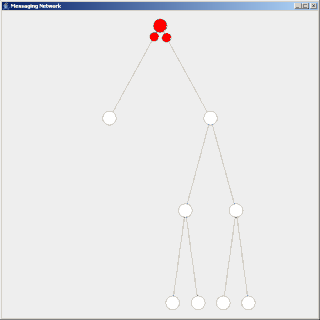Routing is the process of selecting a path for traffic in a network or between or across multiple networks. Broadly, routing is performed in many types of networks, including circuit-switched networks, such as the public switched telephone network (PSTN), and computer networks, such as the Internet.
Link-state routing protocols are one of the two main classes of routing protocols used in packet switching networks for computer communications, the other being distance-vector routing protocols. Examples of link-state routing protocols include Open Shortest Path First (OSPF) and Intermediate System to Intermediate System (IS-IS).

A wireless mesh network (WMN) is a communications network made up of radio nodes organized in a mesh topology. It can also be a form of wireless ad hoc network.

The Optimized Link State Routing Protocol (OLSR) is an IP routing protocol optimized for mobile ad hoc networks, which can also be used on other wireless ad hoc networks. OLSR is a proactive link-state routing protocol, which uses hello and topology control (TC) messages to discover and then disseminate link state information throughout the mobile ad hoc network. Individual nodes use this topology information to compute next hop destinations for all nodes in the network using shortest hop forwarding paths.
Dynamic Source Routing (DSR) is a routing protocol for wireless mesh networks. It is similar to AODV in that it forms a route on-demand when a transmitting node requests one. However, it uses source routing instead of relying on the routing table at each intermediate device.
Packet loss occurs when one or more packets of data travelling across a computer network fail to reach their destination. Packet loss is either caused by errors in data transmission, typically across wireless networks, or network congestion. Packet loss is measured as a percentage of packets lost with respect to packets sent.

Flooding is used in computer networks routing algorithm in which every incoming packet is sent through every outgoing link except the one it arrived on.
A wireless ad hoc network (WANET) or mobile ad hoc network (MANET) is a decentralized type of wireless network. The network is ad hoc because it does not rely on a pre-existing infrastructure, such as routers in wired networks or access points in wireless networks. Instead, each node participates in routing by forwarding data for other nodes, so the determination of which nodes forward data is made dynamically on the basis of network connectivity and the routing algorithm in use.

The Better Approach to Mobile Ad-hoc Networking (B.A.T.M.A.N.) is a routing protocol for multi-hop mobile ad hoc networks which is under development by the German "Freifunk" community and intended to replace the Optimized Link State Routing Protocol (OLSR).
Geographic routing is a routing principle that relies on geographic position information. It is mainly proposed for wireless networks and based on the idea that the source sends a message to the geographic location of the destination instead of using the network address. In the area of packet radio networks, the idea of using position information for routing was first proposed in the 1980s for interconnection networks. Geographic routing requires that each node can determine its own location and that the source is aware of the location of the destination. With this information, a message can be routed to the destination without knowledge of the network topology or a prior route discovery.
Routing in delay-tolerant networking concerns itself with the ability to transport, or route, data from a source to a destination, which is a fundamental ability all communication networks must have. Delay- and disruption-tolerant networks (DTNs) are characterized by their lack of connectivity, resulting in a lack of instantaneous end-to-end paths. In these challenging environments, popular ad hoc routing protocols such as AODV and DSR fail to establish routes. This is due to these protocols trying to first establish a complete route and then, after the route has been established, forward the actual data. However, when instantaneous end-to-end paths are difficult or impossible to establish, routing protocols must take to a "store and forward" approach, where data is incrementally moved and stored throughout the network in hopes that it will eventually reach its destination. A common technique used to maximize the probability of a message being successfully transferred is to replicate many copies of the message in hopes that one will succeed in reaching its destination.
In multi-hop networks, Adaptive Quality of Service routing protocols have become increasingly popular and have numerous applications. One application in which it may be useful is in Mobile ad hoc networking (MANET).
Multipath routing is a routing technique simultaneously using multiple alternative paths through a network. This can yield a variety of benefits such as fault tolerance, increased bandwidth, and improved security.
Vehicular Reactive Routing protocol (VRR) is a reactive routing protocol with geographical features which is specifically designed for Wireless Access for the Vehicular Environment (WAVE) standard in Vehicular ad hoc Networks (VANETs). The protocol takes advantages of the multichannel scheme defined in WAVE and uses the Control Channel (CCH) for signalling, and relies on one of the multiple Service Channels (SCHs) for payload data dissemination.
In wired computer networking, including the Internet, a hop occurs when a packet is passed from one network segment to the next. Data packets pass through routers as they travel between source and destination. The hop count refers to the number of network devices through which data passes from source to destination.
IEEE 802.11s is a wireless LAN standard and an IEEE 802.11 amendment for mesh networking, defining how wireless devices can interconnect to create a wireless LAN (WLAN) mesh network, which may be used for relatively fixed topologies and wireless ad hoc networks. The IEEE 802.11s task group drew upon volunteers from university and industry to provide specifications and possible design solutions for wireless mesh networking. As a standard, the document was iterated and revised many times prior to finalization.
A mobile wireless sensor network (MWSN) can simply be defined as a wireless sensor network (WSN) in which the sensor nodes are mobile. MWSNs are a smaller, emerging field of research in contrast to their well-established predecessor. MWSNs are much more versatile than static sensor networks as they can be deployed in any scenario and cope with rapid topology changes. However, many of their applications are similar, such as environment monitoring or surveillance. Commonly, the nodes consist of a radio transceiver and a microcontroller powered by a battery, as well as some kind of sensor for detecting light, heat, humidity, temperature, etc.
Zebra Media Access Control (Z-MAC) is a network protocol for wireless sensor networks. It controls how a Media Access Control (MAC) accesses a common communication medium of a network.
Associativity-based routing is a mobile routing protocol invented for wireless ad hoc networks, also known as mobile ad hoc networks (MANETs) and wireless mesh networks. ABR was invented in 1993, filed for a U.S. patent in 1996, and granted the patent in 1999. ABR was invented by Chai Keong Toh while doing his Ph.D. at Cambridge University.